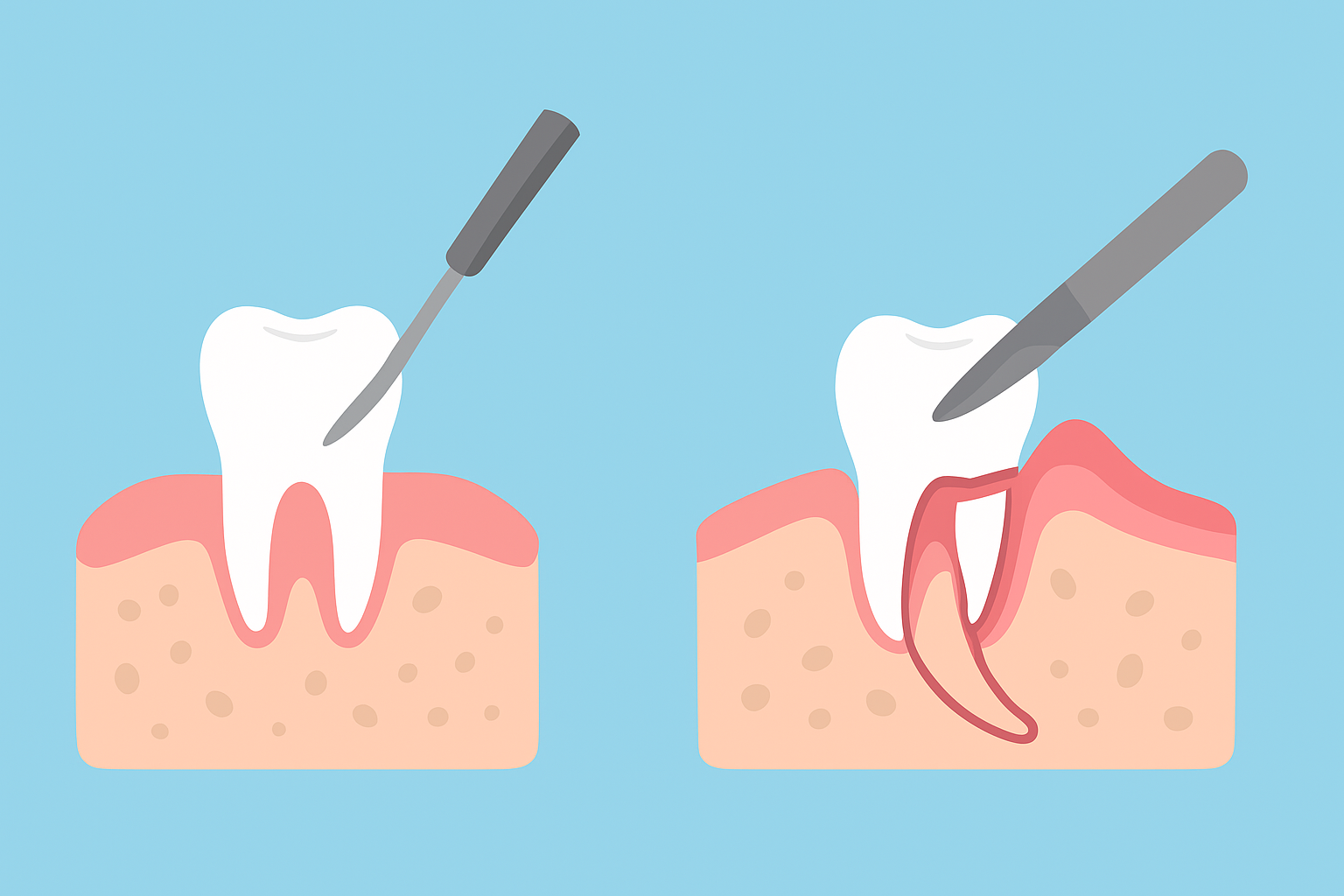Simple vs. Surgical Extractions: What’s the Real Difference?

When it comes to removing a tooth—whether it’s a wisdom tooth, a damaged molar, or one beyond repair—patients often hear two terms that sound similar but mean very different things: simple extraction and surgical extraction.
Understanding the difference matters because it affects the procedure, recovery time, cost, and aftercare. In this guide, we’ll break down how simple and surgical extractions work, what qualifies a tooth for each type, why your oral surgeon might recommend one over the other, and what to expect before, during, and after treatment.
If you’re preparing for wisdom tooth removal, if your dentist flagged a tooth that “needs to come out,” or if you’re researching your options ahead of a consultation, this article will help you feel informed and confident.
What Makes Tooth Extractions Different
Tooth extractions fall into two main categories: simple and surgical. The difference depends on how accessible the tooth is and how much effort is required to remove it safely.
A straightforward, visible tooth can usually be removed with a simple extraction. A tooth that’s trapped under the gums or bone, broken, decayed below the gumline, or angled abnormally often needs a surgical approach.
Both are safe, effective, and common. Knowing what makes each unique helps set expectations, reduce anxiety, and give you a clearer idea of your recovery process.
What Is a Simple Extraction?
A simple extraction is a straightforward procedure where the tooth is fully visible above the gumline and can be removed without surgery.
Dentists and oral surgeons perform simple extractions using local anesthesia, special instruments to loosen the tooth, and gentle pressure to lift it from the socket.
When a Simple Extraction Is Recommended
A dentist may recommend a simple extraction when:
- The tooth is fully erupted
- The roots are straight and not curved
- The shape of the tooth is normal
- There is no deep decay or infection below the gumline
- There’s enough tooth structure left to grasp
Common examples include:
Straightforward Wisdom Teeth
Occasionally, wisdom teeth grow straight, fully emerge, and behave like normal molars—making them ideal candidates for simple extraction.
Non-Wisdom Teeth with Minimal Damage
Teeth removed for orthodontic reasons, crowding, or mild damage often fall into this category.
Baby Teeth That Won’t Fall Out
When baby teeth linger too long and block adult teeth from emerging, a quick simple extraction usually resolves the issue.
What Happens During a Simple Extraction
Simple extractions follow predictable steps with minimal discomfort:
1. Local Anesthesia
The dentist numbs the area so you feel pressure but no pain. Sedation is typically unnecessary unless you experience dental anxiety.
2. Loosening the Tooth
Special instruments gently move the tooth to detach it from the surrounding ligaments.
3. Removing the Tooth
Once loosened, the tooth is lifted out using forceps.
4. Cleaning the Socket
The dentist cleans the socket to prevent infection and promote healing.
5. Placing Gauze
Gauze helps control bleeding and encourages clot formation, the first step of recovery.
Simple extractions generally take only a few minutes, with much faster healing than surgical procedures.
What Is a Surgical Extraction?
A surgical extraction is a more advanced procedure used when a tooth can’t be easily accessed or removed through a simple pull. It may involve making an incision in the gums, removing bone around the tooth, or cutting the tooth into smaller pieces.
Surgical extractions are performed by oral surgeons or dentists trained in surgical techniques. Depending on the complexity, the procedure may involve local anesthesia, sedation, or general anesthesia.
When a Surgical Extraction Is Needed
Surgical extraction is required when:
- The tooth is impacted
- The tooth is broken at or below the gumline
- The roots are curved, long, or fractured
- There is severe decay or infection beneath the gums
- The tooth has not fully erupted
- Bone structure around the tooth requires modification
Typical situations include:
Impacted Wisdom Teeth
Wisdom teeth often grow sideways, remain partially erupted, or stay trapped in the jawbone.
Teeth with Deep Decay or Cracks
If a tooth is too damaged to grip, surgical removal is necessary.
Teeth with Complex Root Anatomy
Roots that curve, split, or fuse with bone require specialized techniques for safe extraction.
What Happens During a Surgical Extraction
Surgical extractions are more detailed but still predictable and safe.
1. Anesthesia and Sedation Options
Depending on the case, your oral surgeon may use:
- Local anesthesia
- Nitrous oxide (laughing gas)
- Oral sedation
- IV sedation
- General anesthesia
Most wisdom tooth extractions are performed with IV sedation for patient comfort.
2. Incision and Access
A small incision is made in the gum to expose the tooth and bone.
3. Bone Removal (If Needed)
If bone covers part of the tooth, a small section is removed to create access.
4. Tooth Sectioning
The tooth may be divided into pieces to make removal gentler on surrounding tissues.
5. Removal of Tooth Sections
Each piece is carefully extracted to ensure complete removal.
6. Cleaning and Irrigation
The area is thoroughly rinsed and cleaned to reduce infection risk.
7. Stitches
Dissolvable or removable stitches are placed depending on the case.
8. Gauze Placement
Gauze controls bleeding and encourages clot formation.
Despite sounding more complex, patients are often surprised by how painless the process feels with proper anesthesia and skilled care.
Simple vs. Surgical Extraction: Key Differences
Factor
Simple Extraction
Surgical Extraction
Tooth Accessibility
Fully visible
Hidden, broken, or impacted
Techniques Used
Basic instruments
Incisions, bone removal, sectioning
Anesthesia Type
Local only
May include sedation or general anesthesia
Recovery Time
1–3 days
1–2 weeks
Cost
Lower
Higher
Common Uses
Erupted teeth, orthodontic removals
Wisdom teeth, impacted or complex roots
Why Wisdom Teeth Usually Require Surgical Extraction
Wisdom teeth are the most common reason for surgical extraction because they often:
- Grow at an angle
- Remain partially or fully trapped in the gums
- Cause crowding or shifting
- Develop cysts or infections
- Damage nearby teeth
For these reasons, oral surgeons typically recommend surgical removal for wisdom teeth to prevent complications.
Recovery: Simple vs. Surgical Extraction
Your recovery time depends heavily on the type of procedure.
Simple Extraction Recovery
Most patients experience:
- Mild soreness for 24–48 hours
- Minimal swelling
- Quick return to normal eating
- Full healing within one week
Pain is usually manageable with over-the-counter medication.
Learn more: Wisdom Teeth Removal Recovery Tips: How to Heal Faster and Avoid Problems
Surgical Extraction Recovery
Surgical recovery may include:
- Swelling peaking at 48–72 hours
- Dietary restrictions for several days
- Prescription pain medication
- Stitches that may require removal
- Recovery lasting 7–14 days
Proper aftercare significantly shortens recovery and reduces discomfort.
How Your Dentist Decides Which Procedure You Need
Your dentist or oral surgeon will determine the extraction type based on:
- Clinical examination
- Digital X-rays
- Root shape and position
- Bone density
- Presence of infection or impaction
Even seemingly simple cases may require surgery after closer evaluation.
Preparing for Tooth Extraction
Preparation can make your experience smoother and recovery faster. Your provider may suggest:
- Avoiding food and drinks before sedation
- Arranging a ride home if sedated
- Pausing certain medications temporarily
- Stocking up on soft foods
- Planning time off for rest
Patients who prepare ahead of time generally experience less stress and faster healing.
Compassionate, Expert Oral Care
At Oral & Facial Surgery of Miami, we’re committed to making every procedure as comfortable and safe as possible. Whether you need a simple or surgical extraction, our team ensures precision, care, and clear communication every step of the way.
Contact Us Today to schedule a consultation.
Final Thoughts
Both simple and surgical extractions are routine, safe dental procedures. The difference lies mainly in how accessible the tooth is and how much surgical work is required to remove it safely.
By understanding the distinction, you can approach your procedure with confidence and peace of mind—knowing that with proper aftercare and a skilled oral surgeon, your outcome will be predictable, safe, and successful.

What to Expect When Getting Your Wisdom Teeth Removed
June 5, 2025

How to Know If Your Wisdom Tooth Is Growing Wrong
November 11, 2025

Mouthwash and Wisdom Teeth: What Really Works
December 16, 2025

Stitches, Bleeding, Numbness: Your Wisdom Tooth Healing Guide
November 14, 2025

What to Eat After Wisdom Teeth Removal: A Complete Recovery Guide
November 26, 2025